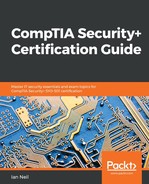Book Description
This is a practical certification guide covering all the exam topics in an easy-to-follow manner backed with mock tests and self-assesment scenarios for better preparation.
Key Features
- Learn cryptography and various cryptography algorithms for real-world implementations
- Discover security policies, plans, and procedures to protect your security infrastructure
- Written by Ian Neil, one of the world's top CompTIA Security+ (SY0-501) trainer
Book Description
CompTIA Security+ is a worldwide certification that establishes the fundamental knowledge required to perform core security functions and pursue an IT security career. CompTIA Security+ Certification Guide is a best-in-class exam study guide that covers all of CompTIA Security+ 501 exam objectives. It is authored by Ian Neil, who is a world-class trainer of CompTIA Security+ 501. Packed with self-assessment scenarios and realistic exam questions, this guide will help you master the core concepts to succeed in the exam the first time you take it.
Using relevant examples, you will learn all the important security fundamentals from Certificates and Encryption to Identity and Access Management concepts. You will then dive into the important domains of the exam; namely, threats, attacks and vulnerabilities, technologies and tools, architecture and design, risk management, and cryptography and Public Key Infrastructure (PKI).
This book comes with over 600 practice questions with detailed explanation that is at the exam level and also includes two mock exams to help you with your study plan. This guide will ensure that encryption and certificates are made easy for you.
What you will learn
- Get to grips with security fundamentals from Certificates and Encryption to Identity and Access Management
- Secure devices and applications that are used by your company
- Identify the different types of malware and virus and take appropriate actions to protect against them
- Protect your environment against social engineering and advanced attacks
- Implement PKI concepts
- Learn about secure coding techniques, quality control, and testing
- Troubleshoot common security issues
Who this book is for
This book is designed for anyone who is seeking to pass the CompTIA Security+ SY0-501 exam. It is a stepping stone for anyone who wants to become a security professional or move into cyber security. This certification guide assumes no prior knowledge of the product.
